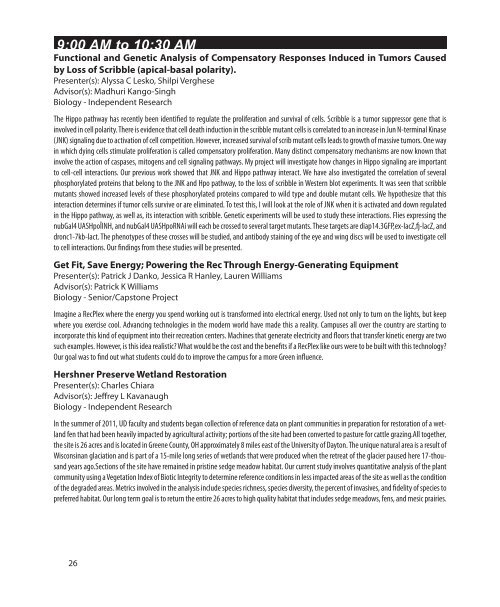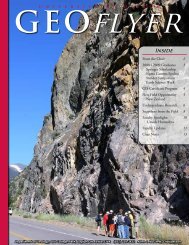Stander Symposium abstract book - University of Dayton
Stander Symposium abstract book - University of Dayton
Stander Symposium abstract book - University of Dayton
You also want an ePaper? Increase the reach of your titles
YUMPU automatically turns print PDFs into web optimized ePapers that Google loves.
9:00 AM to 10:30 AM<br />
Functional and Genetic Analysis <strong>of</strong> Compensatory Responses Induced in Tumors Caused<br />
by Loss <strong>of</strong> Scribble (apical-basal polarity).<br />
Presenter(s): Alyssa C Lesko, Shilpi Verghese<br />
Advisor(s): Madhuri Kango-Singh<br />
Biology - Independent Research<br />
The Hippo pathway has recently been identified to regulate the proliferation and survival <strong>of</strong> cells. Scribble is a tumor suppressor gene that is<br />
involved in cell polarity. There is evidence that cell death induction in the scribble mutant cells is correlated to an increase in Jun N-terminal Kinase<br />
(JNK) signaling due to activation <strong>of</strong> cell competition. However, increased survival <strong>of</strong> scrib mutant cells leads to growth <strong>of</strong> massive tumors. One way<br />
in which dying cells stimulate proliferation is called compensatory proliferation. Many distinct compensatory mechanisms are now known that<br />
involve the action <strong>of</strong> caspases, mitogens and cell signaling pathways. My project will investigate how changes in Hippo signaling are important<br />
to cell-cell interactions. Our previous work showed that JNK and Hippo pathway interact. We have also investigated the correlation <strong>of</strong> several<br />
phosphorylated proteins that belong to the JNK and Hpo pathway, to the loss <strong>of</strong> scribble in Western blot experiments. It was seen that scribble<br />
mutants showed increased levels <strong>of</strong> these phosphorylated proteins compared to wild type and double mutant cells. We hypothesize that this<br />
interaction determines if tumor cells survive or are eliminated. To test this, I will look at the role <strong>of</strong> JNK when it is activated and down regulated<br />
in the Hippo pathway, as well as, its interaction with scribble. Genetic experiments will be used to study these interactions. Flies expressing the<br />
nubGal4 UASHpoÎINH, and nubGal4 UASHpoRNAi will each be crossed to several target mutants. These targets are diap14.3GFP,ex-lacZ,fj-lacZ, and<br />
dronc1-7kb-lact. The phenotypes <strong>of</strong> these crosses will be studied, and antibody staining <strong>of</strong> the eye and wing discs will be used to investigate cell<br />
to cell interactions. Our findings from these studies will be presented.<br />
Get Fit, Save Energy; Powering the Rec Through Energy-Generating Equipment<br />
Presenter(s): Patrick J Danko, Jessica R Hanley, Lauren Williams<br />
Advisor(s): Patrick K Williams<br />
Biology - Senior/Capstone Project<br />
Imagine a RecPlex where the energy you spend working out is transformed into electrical energy. Used not only to turn on the lights, but keep<br />
where you exercise cool. Advancing technologies in the modern world have made this a reality. Campuses all over the country are starting to<br />
incorporate this kind <strong>of</strong> equipment into their recreation centers. Machines that generate electricity and floors that transfer kinetic energy are two<br />
such examples. However, is this idea realistic? What would be the cost and the benefits if a RecPlex like ours were to be built with this technology?<br />
Our goal was to find out what students could do to improve the campus for a more Green influence.<br />
Hershner Preserve Wetland Restoration<br />
Presenter(s): Charles Chiara<br />
Advisor(s): Jeffrey L Kavanaugh<br />
Biology - Independent Research<br />
In the summer <strong>of</strong> 2011, UD faculty and students began collection <strong>of</strong> reference data on plant communities in preparation for restoration <strong>of</strong> a wetland<br />
fen that had been heavily impacted by agricultural activity; portions <strong>of</strong> the site had been converted to pasture for cattle grazing.All together,<br />
the site is 26 acres and is located in Greene County, OH approximately 8 miles east <strong>of</strong> the <strong>University</strong> <strong>of</strong> <strong>Dayton</strong>. The unique natural area is a result <strong>of</strong><br />
Wisconsinan glaciation and is part <strong>of</strong> a 15-mile long series <strong>of</strong> wetlands that were produced when the retreat <strong>of</strong> the glacier paused here 17-thousand<br />
years ago.Sections <strong>of</strong> the site have remained in pristine sedge meadow habitat. Our current study involves quantitative analysis <strong>of</strong> the plant<br />
community using a Vegetation Index <strong>of</strong> Biotic Integrity to determine reference conditions in less impacted areas <strong>of</strong> the site as well as the condition<br />
<strong>of</strong> the degraded areas. Metrics involved in the analysis include species richness, species diversity, the percent <strong>of</strong> invasives, and fidelity <strong>of</strong> species to<br />
preferred habitat. Our long term goal is to return the entire 26 acres to high quality habitat that includes sedge meadows, fens, and mesic prairies.<br />
26

















